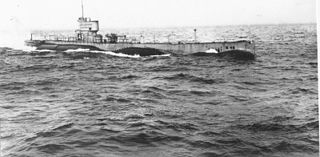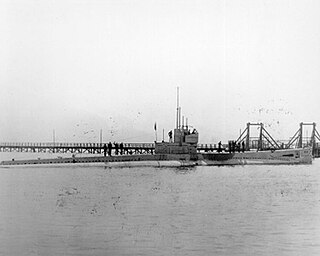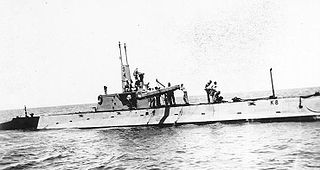
USS Bluefish (SS-222), a Gato-class submarine, was the first ship of the United States Navy to be named for the bluefish. Between 9 September 1943 and 29 July 1945 she completed nine war patrols. Her operating area extended from the Netherlands East Indies to the waters south of Honshū. According to the notoriously unreliable JANAC accounting, Bluefish sank 12 Japanese ships totaling 50,839 tons.

USS Ray (SS/SSR-271), a Gato-class submarine, was the first ship of the United States Navy to be named for the ray, a fish characterized by a flat body, large pectoral fins, and a whiplike tail.

USS S-49 (SS-160) was a fourth-group (S-48) S-class submarine of the United States Navy.

USS S-48 (SS-159) was the first submarine in the fourth group of S-class submarines of the United States Navy.

USS R-1 (SS-78) was the lead ship of the R-class coastal and harbor defense submarines of the United States Navy.

USS R-5 (SS-82) was an R-class coastal and harbor defense submarine of the United States Navy.

USS R-7 (SS-84) was an R-class coastal and harbor defense submarine of the United States Navy.

USS R-21 (SS-98) was an R-class coastal and harbor defense submarine of the United States Navy. Her keel was laid down on 19 April 1917 by the Lake Torpedo Boat Company in Bridgeport, Connecticut; the R-boats built by Lake Torpedo Boat are sometimes considered a separate class from those built by Fore River Shipbuilding and Union Iron Works. She was launched on 10 July 1918 sponsored by Mrs. Dallas C. Laizure and commissioned on 17 June 1919.

USS N-1 (SS-53) was a N-class coastal defense submarine built for the United States Navy during World War I.

USS N-4 (SS-56) was a N-class coastal defense submarine of the United States Navy. Her keel was laid down on 24 March 1915 by Lake Torpedo Boat Company in Bridgeport, Connecticut. The N-boats built by Lake had slightly different specifications from the ones built by Seattle Construction and Drydock and are sometimes considered a separate class.

USS N-6 (SS-58) was a N-class coastal defense submarine of the United States Navy. Her keel was laid down on 15 April 1915 by Lake Torpedo Boat Company in Bridgeport, Connecticut. The N-boats built by Lake had slightly different specifications from the ones built by Seattle Construction and Drydock and are sometimes considered a separate class.

USS N-7 (SS-59) was a N-class coastal defense submarine built for the United States Navy during World War I.

USS K-5 (SS-36) was a K-class submarine of the United States Navy. Her keel was laid down by the Fore River Shipbuilding Company in Quincy, Massachusetts, under a subcontract from the Electric Boat Company of Groton, Connecticut. She was launched on 17 March 1914 sponsored by Mrs. Warren G. Child, and commissioned on 22 August.

USS K-7 (SS-34) was a K-class submarine built for the United States Navy during the 1910s.

USS K-8 (SS-39) was a K-class submarine of the United States Navy. Her keel was laid down by the Union Iron Works in San Francisco, California, under subcontract from Electric Boat Company of Groton, Connecticut. She was launched on 11 July 1914 sponsored by Mrs. John W. Lewis, wife of the first commanding officer, and commissioned on 1 December at Mare Island.

USS G-4 (SS-26) was a G-class submarine of the United States Navy. While the four G-boats were nominally all of a class, they differed enough in significant details that they are sometimes considered to be four unique boats, each in a class by herself.

USS G-2 (SS-27) was a G-class submarine of the United States Navy. While the four G-boats were nominally all of a class, they differed enough in significant details that they are sometimes considered to be four unique boats, each in a class by herself. G-2 was named Tuna when her keel was laid down on 20 October 1909 by the Lake Torpedo Boat Company in Bridgeport, Connecticut, making her the first ship of the United States Navy to be named for the tuna, a large, vigorous, spiny-finned fish highly esteemed for sport and food. She was renamed G-2 on 17 November 1911, launched on 10 January 1912 sponsored by Ms. Marjorie F. Miller, towed to the New York Navy Yard after the termination of the Lake contract on 7 November 1913 where she was completed, and commissioned on 1 December 1913.

USS G-3 (SS-31) was a G-class submarine of the United States Navy. While the four G-boats were nominally all of a class, they differed enough in significant details that they are sometimes considered to be four unique boats, each in a class by herself. G-3 was named Turbot when her keel was laid down on 30 March 1911 by the Lake Torpedo Boat Company in Bridgeport, Connecticut, making her the first ship of the United States Navy to be named for the turbot, a large, brown and white flatfish, valued as a food. She was renamed G-3 on 17 November 1911, transferred to the New York Navy Yard for completion on 17 November 1913 following the cancellation of the Lake contract, launched on 27 December 1913, and commissioned on 22 March 1915.

USS Sicard (DD-346/DM-21/AG-100) was a Clemson-class destroyer in the United States Navy following World War I. She was named for Montgomery Sicard.
USS Charles Whittemore (ID-3232) was a four masted lumber schooner used as a decoy ship against German U-boats during World War I.



















